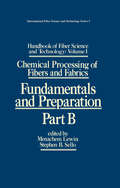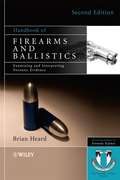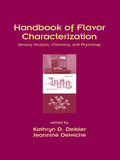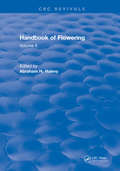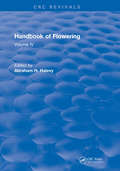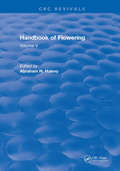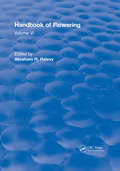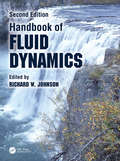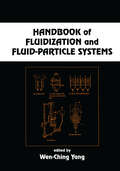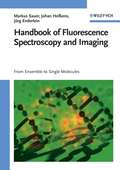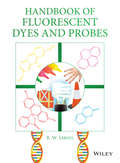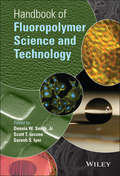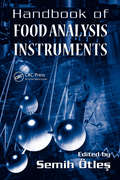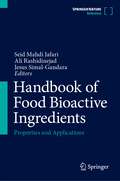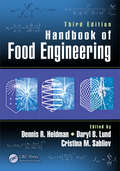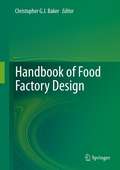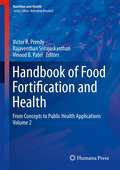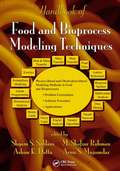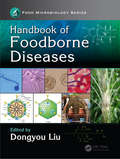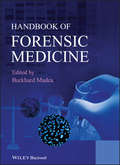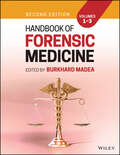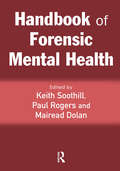- Table View
- List View
Handbook of Fiber Science and Technology: Chemical Processing of Fibers and Fabrics - Fundamentals and Preparation Part B
by Menachem Lewin and Stephen B. SelloContinuing the outstanding coverage from Part A, the authoritative information inFundamentals and Preparation, Part B rounds out the first comprehensive treatise onchemical processing of textiles. A systematic, single-source treatment of key topics inthe field, this state-of-the-art work introduces major savings in time and cost to yourwork with fibers and fabrics .. . provides a foundation for projecting future developments. .. and guides you to useful further study with helpful, current references.As new advances expand the scope of this field , each volume of Handbook of FiberScience and Technology becomes an indispensable acquisition for researchers. Textile, fiber , polymer, organic, physical, and biological chemists; textile finishers andchemical manufacturers; research and development personnel in the polymer, fiber,chemical, and textile industries ; plastics and chemical engineers; materials scientists ;and wood and paper technologists will find them essential references. They are eminentsources for supplementary reading in graduate and advanced undergraduate coursesincluding polymer, fiber, and textile chemistry and technology; chemical processing offibers; chemical engineering ; and polymer processing.
Handbook of Firearms and Ballistics
by Brian J. HeardThe updated second edition of Handbook of Firearms and Ballistics includes recent developed analytical techniques and methodologies with a more comprehensive glossary, additional material, and new case studies. With a new chapter on the determination of bullet caliber via x-ray photography, this edition includes revised material on muzzle attachments, proof marks, non-toxic bullets, and gunshot residues. Essential reading for forensic scientists, firearms examiners, defense and prosecution practitioners, the judiciary, and police force, this book is also a helpful reference guide for undergraduate and graduate forensic science students.
Handbook of Flavor Characterization: Sensory Analysis, Chemistry, and Physiology (Food Science And Technology Ser. #Vol. 131)
by Kathryn D. Deibler Jeannine DelwicheThis multidisciplinary resource details the challenges and analytical methodologies utilized to determine the effect of chemical composition, genetics, and human physiology on aroma and flavor perception. Identifying emerging analytical methods and future research paths, the Handbook of Flavor Characterization studies the interpretation and analysis of flavor and odor with in-depth research from renowned field professionals covering burgeoning areas of interest including genomics and in vivo mass spectrometer techniques. The book examines a wide range of sample preparation methods and conditions, and offers several comparisons of chemical detector sensitivities.
Handbook of Flowering: Volume I
by Abraham H. HalevyThese volumes are an exhaustive source of information on the control and regulation of flowering. They present data on the factors controlling flower induction and how they may be affected by climate and chemical treatments. For each plant, specific information is provided on all aspects of flower development, including sex expression, requirements for flowering initiation and development, photoperiod, light density, vernalization, and other temperature effects and interactions. Individual species are described from the standpoint of juvenility and maturation, morphology, induction and morphogenesis to anthesis. All information is presented alphabetically for easy reference
Handbook of Flowering: Volume II
by Abraham H. HalevyThese volumes are an exhaustive source of information on the control and regulation of flowering. They present data on the factors controlling flower induction and how they may be affected by climate and chemical treatments. For each plant, specific information is provided on all aspects of flower development, including sex expression, requirements for flowering initiation and development, photoperiod, light density, vernalization, and other temperature effects and interactions. Individual species are described from the standpoint of juvenility and maturation, morphology, induction and morphogenesis to anthesis. All information is presented alphabetically for easy reference
Handbook of Flowering: Volume III
by Abraham H. HalevyThese volumes are an exhaustive source of information on the control and regulation of flowering. They present data on the factors controlling flower induction and how they may be affected by climate and chemical treatments. For each plant, specific information is provided on all aspects of flower development, including sex expression, requirements for flowering initiation and development, photoperiod, light density, vernalization, and other temperature effects and interactions. Individual species are described from the standpoint of juvenility and maturation, morphology, induction and morphogenesis to anthesis. All information is presented alphabetically for easy reference
Handbook of Flowering: Volume IV
by Abraham H. HalevyThese volumes are an exhaustive source of information on the control and regulation of flowering. They present data on the factors controlling flower induction and how they may be affected by climate and chemical treatments. For each plant, specific information is provided on all aspects of flower development, including sex expression, requirements for flowering initiation and development, photoperiod, light density, vernalization, and other temperature effects and interactions. Individual species are described from the standpoint of juvenility and maturation, morphology, induction and morphogenesis to anthesis. All information is presented alphabetically for easy reference
Handbook of Flowering: Volume V
by Abraham H. HalevyThese volumes are an exhaustive source of information on the control and regulation of flowering. They present data on the factors controlling flower induction and how they may be affected by climate and chemical treatments. For each plant, specific information is provided on all aspects of flower development, including sex expression, requirements for flowering initiation and development, photoperiod, light density, vernalization, and other temperature effects and interactions. Individual species are described from the standpoint of juvenility and maturation, morphology, induction and morphogenesis to anthesis. All information is presented alphabetically for easy reference
Handbook of Flowering: Volume VI
by Abraham H. HalevyThese volumes are an exhaustive source of information on the control and regulation of flowering. They present data on the factors controlling flower induction and how they may be affected by climate and chemical treatments. For each plant, specific information is provided on all aspects of flower development, including sex expression, requirements for flowering initiation and development, photoperiod, light density, vernalization, and other temperature effects and interactions. Individual species are described from the standpoint of juvenility and maturation, morphology, induction and morphogenesis to anthesis. All information is presented alphabetically for easy reference
Handbook of Fluid Dynamics
by Richard W. JohnsonHandbook of Fluid Dynamics offers balanced coverage of the three traditional areas of fluid dynamics—theoretical, computational, and experimental—complete with valuable appendices presenting the mathematics of fluid dynamics, tables of dimensionless numbers, and tables of the properties of gases and vapors. Each chapter introduces a different fluid dynamics topic, discusses the pertinent issues, outlines proven techniques for addressing those issues, and supplies useful references for further research.Covering all major aspects of classical and modern fluid dynamics, this fully updated Second Edition: Reflects the latest fluid dynamics research and engineering applications Includes new sections on emerging fields, most notably micro- and nanofluidics Surveys the range of numerical and computational methods used in fluid dynamics analysis and design Expands the scope of a number of contemporary topics by incorporating new experimental methods, more numerical approaches, and additional areas for the application of fluid dynamics Handbook of Fluid Dynamics, Second Edition provides an indispensable resource for professionals entering the field of fluid dynamics. The book also enables experts specialized in areas outside fluid dynamics to become familiar with the field.
Handbook of Fluidization and Fluid-Particle Systems (Chemical Industries)
by Wen-Ching YangThis reference details particle characterization, dynamics, manufacturing, handling, and processing for the employment of multiphase reactors, as well as procedures in reactor scale-up and design for applications in the chemical, mineral, petroleum, power, cement and pharmaceuticals industries. The authors discuss flow through fixed beds, elutriation and entrainment, gas distributor and plenum design in fluidized beds, effect of internal tubes and baffles, general approaches to reactor design, applications for gasifiers and combustors, dilute phase pneumatic conveying, and applications for chemical production and processing. This is a valuable guide for chemists and engineers to use in their day-to-day work.
Handbook of Fluorescence Spectroscopy and Imaging: From Ensemble to Single Molecules
by Markus Sauer Johan Hofkens Jörg EnderleinProviding much-needed information on fluorescence spectroscopy and microscopy, this ready reference covers detection techniques, data registration, and the use of spectroscopic tools, as well as new techniques for improving the resolution of optical microscopy below the resolution gap. Starting with the basic principles, the book goes on to treat fluorophores and labeling, single-molecule fluorescence spectroscopy and enzymatics, as well as excited state energy transfer, and super-resolution fluorescence imaging. Examples show how each technique can help in obtaining detailed and refined information from individual molecular systems.
Handbook of Fluorescent Dyes and Probes
by R. W. SabnisA COMPLETE, UP-TO-DATE RESOURCE OF INFORMATION ON MORE THAN 150 FLUORESCENT DYES AND PROBES Handbook of Fluorescent Dyes and Probes is the most comprehensive volume available on the subject, covering all the available dyes and probes known to date in the literature for uses in various fields. Top dye expert Dr. Ram Sabnis organizes the compounds alphabetically by the most commonly used chemical name. He presents an easy-to-use reference complete with novel ideas for breakthrough research in medical, biological, chemical, color, material, physical and related allied fields. The ease of use of the handbook is further enhanced by various appendixes provided at the end of the book to conveniently and easily locate the dye as per the reader's need. This is the first book to give the CAS registry numbers, chemical structure, Chemical Abstract (CA) index name, all other chemical names, Merck Index number, chemical/dye class, molecular formula, molecular weight, physical form, solubility, melting point, boiling point, pKa, absorption maxima, emission maxima, molar extinction coefficient, and quantum yield of fluorescent dyes and probes, as well as to provide access to synthetic procedures (lab scale and industrial scale) of dyes and probes in a single source. This user-friendly handbook also features references on safety, toxicity and adverse effects of dyes and probes on humans, animals and the environment, including: acute/chronic toxicityaquatic toxicitycarcinogenicitycytotoxicityecotoxicitygenotoxocityhematotoxicityhepatotoxicityimmunotoxicitymarine toxicitymicrobial toxicitymutagenicitynephrotoxicityneurotoxicitynucleic acid damageoral toxicityphototoxicityphytotoxicityreproductive toxicityskin toxicity Containing imaging/labeling applications, biological/medical applications and industrial applications, Handbook of Fluorescent Dyes and Probes is a convenient, vital resource for industrial and academic researchers, and a valuable desktop reference for medical professionals, lab supervisors, scientists, chemists, biologists, engineers, physicists, intellectual property professionals, students, and professors. presentations. Dr. Sabnis is the recipient of the Perkin Innovation Award, Grand Innovation Award, Competitive Spirit Award, and Best Doctoral Thesis Award. He has written two books on color chemistry, namely, "Handbook of Biological Dyes and Stains" and "Handbook of Acid-Base Indicators."
Handbook of Fluoropolymer Science and Technology
by Scott T. Iacono Dennis W. Smith Suresh S. IyerFluoropolymers continue to enable new materials and technologies as a result of their remarkable properties. This book reviews fluoropolymer platforms of established commercial interest, as well as recently discovered methods for the preparation and processing of new fluorinated materials. It covers the research and development of fluoropolymer synthesis, characterization, and processing. Emphasis is placed on emerging technologies in optics, space exploration, fuel cells, microelectronics, gas separation membranes, biomedical instrumentation, and much more.In addition, the book covers the current environmental concerns associated with fluoropolymers, as well as relevant regulations and potential growth opportunities. Concepts, studies, and new discoveries are taken from leading international laboratories, including academia, government, and industrial institutions.
Handbook of Food Analysis Instruments
by TrevorExplore the Pros and Cons of Food Analysis InstrumentsThe identification, speciation, and determination of components, additives, and contaminants in raw materials and products will always be a critical task in food processing and manufacturing. With contributions from leading scientists, many of whom actually developed or refined each technique or
Handbook of Food Bioactive Ingredients: Properties and Applications
by Seid Mahdi Jafari Ali Rashidinejad Jesus Simal-GandaraBioactive ingredients, including both bioactive compounds and bioactive live organisms, are present in small amounts in natural sources such as fruits and vegetables. These ingredients have been continuously investigated during the last few decades and the epidemiological data suggest that their intake is associated with significant decreased risk of various disorders and chronic diseases owing to their anti-oxidant, anti-bacterial and anti-inflammatory qualities. Some of these natural ingredients such as catechins, curcumin, resveratrol, oleuropein, quercetin, rutin, hesperidin, sulforaphane, ellagic acid, and anthocyanins, have been studied as factors with possible direct or indirect effect on specific molecular pathways which are playing vital roles in the association with the pathophysiology of the chronic diseases such as cancer. In light of this, natural foods and food-derived products rich in bioactives have received recent growing attention. It has been reported that frequent consumption of fruits, vegetables, and their associated natural products have many health-promoting benefits that protect against degenerative illnesses including heart disease, arthritis, cancer, immune system decline, brain dysfunction, inflammation and cataracts. Functional foods and medicinal supplements containing encapsulated bioactive materials will be the future of new emerging products in the food and pharma industries. Such products present therapeutical and medicinal properties that can prevent and/or cure specific chronic diseases and disorders. Handbook Of Bioactive Ingredients provides a systematic overview of different food bioactive ingredients describing their chemistry, structure, functionality, safety/toxicity, oral delivery and their applications in functional foods. Detailed chapters will describe various bioactive ingredients including polyphenolic compounds such as phenolic acids, flavonoids and anthocyanins, carotenoids, sterols such as non-oxygenated carotenoids, xanthophylls and phytosterols, bioactive peptides such as marine bioactive peptides, animal bioactive peptides, plant bioactive peptides, microbial bioactive peptides, essential fatty acids like fish and marine oils and plant oils, live organisms like probiotics and yeasts, essential oils and oleoresins like monoterpens, sequiterpens and oleoresins, vitamins and minerals including liposoluble vitamins, hydrosoluble vitamins and trace minerals), and other bioactive compounds including prebiotics, oligosaccharides, dietary fibers and beta-glucan. This book is the first comprehensive collection of scientific evidence form published literature on natural bioactive ingredients.
Handbook of Food Engineering
by Edited by Dennis R. Heldman Daryl B. Lund Cristina M. SabliovAs the complexity of the food supply system increases, the focus on processes used to convert raw food materials and ingredients into consumer food products becomes more important. The Handbook of Food Engineering, Third Edition, continues to provide students and food engineering professionals with the latest information needed to improve the efficiency of the food supply system.As with the previous editions, this book contains the latest information on the thermophysical properties of foods and kinetic constants needed to estimate changes in key components of foods during manufacturing and distribution. Illustrations are used to demonstrate the applications of the information to process design. Researchers should be able to use the information to pursue new directions in process development and design, and to identify future directions for research on the physical properties of foods and kinetics of changes in the food throughout the supply system.Features Covers basic concepts of transport and storage of liquids and solids, heating and cooling of foods, and food ingredients New chapter covers nanoscale science in food systems Includes chapters on mass transfer in foods and membrane processes for liquid concentration and other applications Discusses specific unit operations on freezing, concentration, dehydration, thermal processing, and extrusion The first four chapters of the Third Edition focus primarily on the properties of foods and food ingredients with a new chapter on nanoscale applications in foods. Each of the eleven chapters that follow has a focus on one of the more traditional unit operations used throughout the food supply system. Major revisions and/or updates have been incorporated into chapters on heating and cooling processes, membrane processes, extrusion processes, and cleaning operations.
Handbook of Food Factory Design
by Christopher G. BakerFood manufacturing has evolved over the centuries from kitchen industries to modern, sophisticated production operations. A typical food factory includes the food processing and packaging lines, the buildings and exterior landscaping, and the utility-supply and waste-treatment facilities. As a single individual is unlikely to possess all the necessary skills required to facilitate the design, the task will undoubtedly be undertaken by an interdisciplinary team employing a holistic approach based on a knowledge of the natural and biological sciences, most engineering disciplines, and relevant legislation. In addition, every successful project requires a competent project manager to ensure that all tasks are completed on time and within budget. This Handbook attempts to compress comprehensive, up-to-date coverage of these areas into a single volume. It is hoped that it will prove to be of value across the food-manufacturing community. The multi-disciplinary nature of the subject matter should facilitate more informed communication between individual specialists on the team. It should also provide useful background information on food factory design for a wider range of professionals with a more peripheral interest in the subject: for example, process plant suppliers, contractors, HSE specialists, retailers, consultants, and financial institutions. Finally, it is hoped that it will also prove to be a valuable reference for students and instructors in the areas of food technology, chemical engineering, and mechanical engineering, in particular.
Handbook of Food Fortification and Health: From Concepts to Public Health Applications Volume 1
by Victor R. Preedy Vinood B. Patel Rajaventhan SrirajaskanthanHandbook of Food Fortification and Health: From Concepts to Public Health Applications Volume 1 represents a multidisciplinary approach to food fortification. This book aims to disseminate important material pertaining to the fortification of foods from strategic initiatives to public health applications. Optimal nutritional intake is an essential component of health and wellbeing. Unfortunately situations arise on a local or national scale when nutrient supply or intake is deemed to be suboptimal. As a consequence, ill health occurs affecting individual organs or causing premature death. In terms of public health, malnutrition due to micronutrient deficiency can be quite profound imposing economic and social burdens on individuals and whole communities. This comprehensive text examines the broad spectrum of food fortification in all its manifestations. Coverage includes sections on definitions of fortifications, fortified foods, beverages and nutrients, fortifications with micronutrients, biofortification, impact on individuals, public health concepts and issues, and selective methods and food chemistry. Handbook of Food Fortification and Health: From Concepts to Public Health Applications Volume 1 is an indispensable text designed for nutritionists, dietitians, clinicians and health related professionals.
Handbook of Food and Bioprocess Modeling Techniques
by Arun S. Mujumdar Ashim K. Datta Shyam S. Sablani M. Shafiur RahmanWith the advancement of computers, the use of modeling to reduce time and expense, and improve process optimization, predictive capability, process automation, and control possibilities, is now an integral part of food science and engineering. New technology and ease of use expands the range of techniques that scientists and researchers have at the
Handbook of Foodborne Diseases (Food Microbiology)
by Dongyou LiuClearly linked to consumption of foods, beverages, and drinking water that contain pathogenic microbes, toxins, or other toxic agents, foodborne diseases have undergone a remarkable change of fortune in recent decades, from once rare and insignificant malaises to headline-grabbing and deadly outbreaks. Unquestionably, several factors have combined to make this happen. These include a prevailing demand for the convenience of ready-to-eat or heat-and-eat manufactured food products that allow ready entry and survival of some robust, temperature-insensitive microorganisms; a drastic reduction in the costs of air, sea, and road transportation that has taken some pathogenic microorganisms to where they were absent previously; an expanding world population that has stretched the boundary of human activity; and an ageing population whose weakened immune functions provide a fertile ground for opportunistic pathogens to invade and thrive. Given the diversity of causative agents (ranging from viruses, bacteria, yeasts, filamentous fungi, protozoa, helminthes, toxins, to toxic agents), and the ingenuity of pathogenic microbes to evolve through genetic reassortment, horizontal gene transfer, and/or random genetic mutation, it has become an enormous challenge to understand how foodborne agents are able to evade host immune defenses and induce diseases, and also to develop and apply innovative approaches for improved diagnosis, treatment, and prevention of foodborne diseases. Handbook of Foodborne Diseases summarizes the latest findings on more than 100 foodborne diseases and their causative agents. With contributions from international experts on foodborne pathogens, toxins, and toxic agents research, this volume provides state-of-the-art overviews on foodborne diseases in relation to their etiology, biology, epidemiology, clinical presentation, pathogenesis, diagnosis, treatment, and prevention. Apart from offering a comprehensive textbook for undergraduate and postgraduate students in food, medical, and veterinary microbiology, this volume constitutes a valuable reference on foodborne diseases for medical professionals and health authorities, and forms an informative educational resource for the general public.
Handbook of Forensic Medicine
by Burkhard MadeaForensic Medicine encompasses all areas in which medicine and law interact. This book covers diverse aspects of forensic medicine including forensic pathology, traumatology and violent death, sudden and unexpected death, clinical forensic medicine, toxicology, traffic medicine, identification, haemogenetics and medical law. A knowledge of all these subdisciplines is necessary in order to solve routine as well as more unusual cases.Taking a comprehensive approach the book m.oves beyond a focus on forensic pathology to include clinical forensic medicine and forensic toxicology. All aspects of forensic medicine are covered to meet the specialist needs of daily casework. Aspects of routine analysis and quality control are addressed in each chapter. The book provides coverage of the latest developments in forensic molecular biology, forensic toxicology, molecular pathology and immunohistochemistry.A must-have reference for every specialist in the field this book is set to become the bench-mark for the international forensic medical community.
Handbook of Forensic Medicine
by Burkhard MadeaHANDBOOK OF FORENSIC MEDICINE The gold standard in forensic medicine references In the Second Edition of Handbook of Forensic Medicine, editor Burkhard Madea brings to the reader, through a global team of expert contributors, a comprehensive and international approach to forensic medicine. In addition to offering new coverage of crime scene investigation, blood stain pattern analysis, terrorist attacks, fire disasters, new psychoactive substances, and molecular pathology, the book provides a thorough review of all aspects of forensic medicine. The chapters represent all aspects of quality control and best practice and include case studies throughout to help illustrate the concepts discussed within and emphasize the links between diverse subdisciplines. Specialists engaged in daily casework will find that aspects of routine analysis are addressed in each chapter. Handbook of Forensic Medicine 2e also covers the latest developments in forensic molecular biology, forensic toxicology, molecular pathology, and immunohistochemistry. It also offers: A thorough introduction to the duties of forensic medicine in modern societies, including discussions of the international guidelines and accreditation in forensic medicine Comprehensive explorations of medical aspects of death, including the nature and definition of death, autopsy, and mass disaster victim identification Practical discussions of traumatology and violent death, including asphyxiation, electrocution and lightning, infanticide, and medical malpractice In-depth examinations of sudden and unexpected death from natural causes, including postmortem biochemistry This is a must-read resource for every specialist in forensic medicine, toxicology, and haemogenetics, as well as anyone expected to prepare a report for court proceedings. It’s also an ideal reference for lawyers and law students.
Handbook of Forensic Mental Health
by Paul Rogers Keith Soothill Mairead DolanThis is a comprehensive reference book on the subject of forensic mental health, looking at what forensic mental health is and its assessment, management and treatment. It focuses on key topics and the issues underpinning them in contemporary society. The book includes: an account of the historical development of forensic mental health, along with a description of the three mental health systems operating in the UK an in-depth analysis of the forensic mental health process and system, including an analysis of the different systems applied for juveniles and adults an examination of the main issues in forensic mental health including sex offending, personality disorders and addiction a breakdown of the key skills needed for forensic mental health practice. This is an authoritative reference book which will be a crucial text for practitioners, academics and students in the forensic mental health field.
